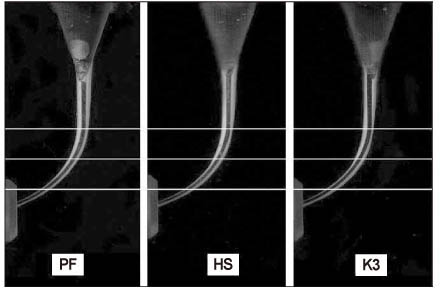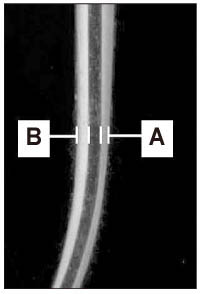J Korean Acad Conserv Dent.
2006 Jan;31(1):1-10. 10.5395/JKACD.2006.31.1.001.
Comparison of shaping ability of rotary Ni-Ti file systems used by undergraduates
- Affiliations
-
- 1Department of Conservative Dentistry, College of Dentistry, Pusan National University, Korea. jeongkil@pusan.ac.kr
- KMID: 2175773
- DOI: http://doi.org/10.5395/JKACD.2006.31.1.001
Abstract
- The purpose of this study was to compare the shaping ability of three Ni-Ti file systems used by dental students or the experts and consequently to aid in choosing a proper systems for educational courses of dental students and beginners. Fifty students and ten dentists who have clinical experience over two years prepared 180 simulated root canals in resin blocks with three Ni-Ti systems; ProFile(R) (PF), HeroShaper(R) (HS), K3TM (K3). After preparation, the Ni-Ti files were evaluated for distortion and canal preparation time was recorded. The images of pre- and post-instrumented canals were scanned and superimposed. Amounts of increased canal widths, deviation, and centering ratio were calculated at apical 1, 3 and 5 mm levels and statistical analysis was performed. The results were as follows: 1. HS showed the shortest preparation time and instrumented canal width in K3 was significantly larger than other groups (P < 0.05). 2. At 1 and 3 mm levels, all groups had outward deviation. In student group, at the 1 mm level, PF had the least deviation (P < 0.05). 3. In the centering ratio, the PF had the best centering ability compared to the others at 5 mm level. At 1 and 3 mm levels, HS and PF had better abilities than K3. Student group had better ratio than the expert at 3 mm level with PF (P < 0.05). Based on the results, it is surmised that the ProFile(R) is the safest and most ideal instrument for students and beginners.
Keyword
Figure
Cited by 1 articles
-
A comparison of the shaping ability of four rotary nickel-titanium files in simulated root canals
Bo-Hye Kim, Kyoung-Kyu Choi, Sang-Hyuk Park, Gi-Woon Choi
J Korean Acad Conserv Dent. 2010;35(2):88-95. doi: 10.5395/JKACD.2010.35.2.088.
Reference
-
1. Garip Y, Gunday M. The use of computed tomography when comparing nickel-titanium and stainless steel files during preparation of simulated curved canals. Int Endod J. 2001. 34(6):452–457.
Article2. Baumann MA, Roth A. Effect of experience on quality of canal preparation with rotary nickel-titanium files. Oral Surg Oral Med Oral Pathol Oral Radiol Endod. 1999. 88(6):714–718.
Article3. Schafer E, Schulz-Bongert U, Tulus G. Comparison of hand stainless steel and nickel titanium rotary instrumentation: a clinical study. J Endod. 2004. 30(6):432–435.
Article4. Peters OA. Current Challenges and Concepts in the Preparation of Root Canal Systems: A Review. J Endod. 2004. 30(8):559–567.
Article5. Bergmans L, Van Cleynenbreugel J, Beullens M, Wevers M, Van Meerbeek B, Lambrechts P. Progressive versus constant tapered shaft design using NiTi rotary instruments. Int Endod J. 2003. 36(4):288–295.
Article6. Clauder T, Baumann MA. ProTaper NT system. Dent Clin North Am. 2004. 48(1):87–111.
Article7. Schafer E. Shaping ability of Hero 642 rotary nickel-titanium instruments and stainless steel hand K-Flexofiles in simulated curved root canals. Oral Surg Oral Med Oral Pathol Oral Radiol Endod. 2001. 92(2):215–220.
Article8. Hata G, Uemura M, Kato AS, Imura N, Novo NF, Toda T. A comparison of shaping ability using ProFile, GT file, and Flex-R endodontic instruments in simulated canals. J Endod. 2002. 28(4):316–321.
Article9. Ankrum MT, Hartwell GR, Truitt JE. K3 Endo, ProTaper, and ProFile systems: breakage and distortion in severely curved roots of molars. J Endod. 2004. 30(4):234–237.
Article10. Park WK, Lee HJ, Hur B. Shaping ability of nickel-titaniumrotary files. J Korean Acad Conserv Dent. 2004. 29(1):44–50.
Article11. Qualtrough AJ, Dummer PM. Undergraduate endodontic teaching in the United Kingdom: an update. Int Endod J. 1997. 30(4):234–239.
Article12. Qualtrough AJ, Whitworth JM, Dummer PM. Preclinical endodontology: an international comparison. Int Endod J. 1999. 32(5):406–414.
Article13. Sonntag D, Guntermann A, Kim SK, Stachniss V. Root canal shaping with manual stainless steel files and rotary Ni-Ti files performed by students. Int Endod J. 2003. 36(4):246–255.
Article14. Sonntag D, Delschen S, Stachniww V. Root-canal shaping with manual and rotary Ni-Ti files performed by students. Int Endod J. 2003. 36(11):715–723.
Article15. Hanni S, Schonenberger K, Peters OA, Barbakow F. Teaching an engine-driven preparation technique to undergraduates: initial observations. Int Endod J. 2003. 36(7):476–482.
Article16. Calhoun G, Montgomery S. The effects of four instrumentation techniques on root canal shape. J Endod. 1988. 14(6):273–277.
Article17. Kosa DA, Marshall G, Baumgartner JC. An analysis of canal centering using mechanical instrumentation techniques. J Endod. 1999. 25(6):441–445.
Article18. Parashos P, Messer HH. Questionnaire survey on the use of rotary nickel-titanium endodontic instruments by Australian dentists. Int Endod J. 2004. 37(4):249–259.
Article19. Yared G, Bou Dagher F, Kulkarni K. Influence of torque control motors and the operator's proficiency on ProTaper failures. Oral Surg Oral Med Oral Pathol Oral Radiol Endod. 2003. 96(2):229–233.
Article20. Yared GM, Kulkarni GK. Failure of ProFile Ni-Ti instruments used by an inexperienced operator under access limitations. Int Endod J. 2002. 35:536–541.
Article21. Gambarini G. Cyclic fatigue of ProFile rotary instruments after prolonged clinical use. Int Endod J. 2001. 34:386–389.
Article22. Szep S, Gerhardt T, Leitzbach C, Luder W, Heidemann D. Preparation of severely curved simulated root canals using engine-driven rotary and conventional hand instruments. Clin Oral Investig. 2001. 5(1):17–25.
Article23. Yared GM, Dagher FE, Machtou P, Kulkarni GK. Influence of rotational speed, torque and operator proficiency on failure of Greater Taper files. Int Endod J. 2002. 35(1):7–12.
Article24. Yared GM, Bou dagher FE, Machtou P. Cyclic fatigue of ProFile rotary instruments after clinical use. Int Endod J. 2000. 33:204–207.
Article25. Park SH, Cho KM, Kim JW. The Efficiency of the Ni-Ti Rotary files in Curved Simulated Canals Shaped by Novice Operators. J Korean Acad Conserv Dent. 2003. 28(2):146–155.
Article26. Yun HH, Kim SK. A comparison of the shaping abilities of 4 nickel-titanium rotary instruments in simulated root canals. Oral Surg Oral Med Oral Pathol Oral Radiol Endod. 2003. 95(2):228–233.
Article27. Schafer E, Vlassis M. Comparative investigation of two rotary nickel-titanium instruments: ProTaper versus RaCe. Part 1. Shaping ability in simulated curved canals. Int Endod J. 2004. 37(4):229–238.
Article28. Ko HJ, Baek SH. A study of histomorphological change of curved root canal preparation using GT rotary file, profile and stainless steel K-file. J Korean Acad Conserv Dent. 2002. 27(6):612–618.
Article29. Dobo-Nagy C, Serban T, Szabo J, Nagy G, Madlena M. A comparison of the shaping characteristics of two nickel-titanium endodontic hand instruments. Int Endod J. 2002. 35:283–288.
Article30. Song YL, Bian Z, Fan B, Fan MW, Gutmann JL, Peng B. A comparison of instrument-centering ability within the root canal for three contemporary instrumentation techniques. Int Endod J. 2004. 37:265–271.
Article31. Kim HC, Park JK, Hur B. Relative efficacy of three Ni-Ti file systems used by undergraduates. J Korean Acad Conserv Dent. 2005. 30(1):38–48.
Article32. Berutti E, Chiandussi G, Gaviglio I, Ibba A. Comparative analysis of torsional and bending stresses in two mathematical models of nickel-titanium rotary instruments: ProTaper versus ProFile. J Endod. 2003. 29(1):15–19.
Article
- Full Text Links
- Actions
-
Cited
- CITED
-
- Close
- Share
- Similar articles
-
- Relative efficacy of three Ni-Ti file systems used by undergraduates
- Shaping ability of Ni-Ti rotary files in combination with GT rotary Ni-Ti file
- A comparative study of the canal configuration after shaping by protaper rotary and hand files in resin simulated canals
- A study of insertion depth of buchanan plugger after shaping using NI-TI rotary files in simulated resin root canals
- A comparison of the shaping ability of four rotary nickel-titanium files in simulated root canals



